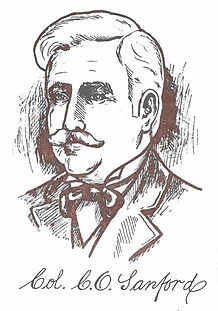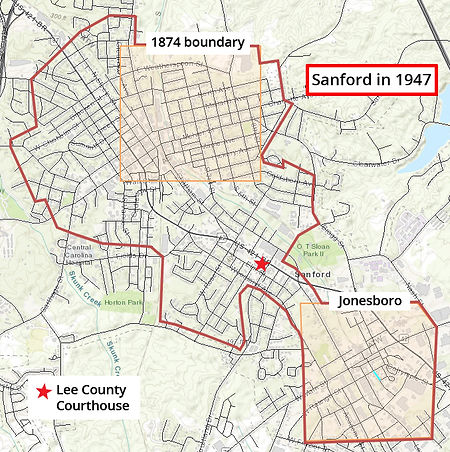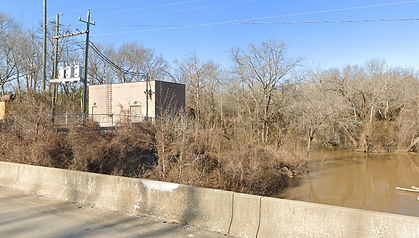
150 Years of Progress
The City of Sanford's Sesquicentennial Committee is celebrating the rich and diverse stories of Sanford's past, present, and future during its 150th birthday year.
Here is a brief history of the past 150 years of progress:
Post Civil War
The railroad travels south.
After the Civil War, the Raleigh and Augusta Air Line Railroad built southward to Moore County, where it crossed the Western Railroad tracks. At this junction and passenger point, a rail-born village grew.


1870
A busy community starts building.
A railroad house was built to provide a home for the community's first rail agent William Thomas Tucker and his wife Inder. After Sanford's incorporation, Tucker was appointed Sanford's first mayor.
During this time, Sanford's first church is established. A congregation from Chatham County began meeting in a building on Wicker Street. They named their church "Fair Promise" in honor of founding member Promise C. Holmes.
1874
Sanford is incorporated.
On February 11, 1874, the North Carolina General Assembly passed "An Act to Incorporate the Town of Sanford” in then-Moore County, North Carolina. Sanford, which started as 1 square mile, was named in honor of railroad engineer Col. Charles Ogden Sanford.
Sanford was known for having many taverns and only one church. The 1880 census documents 236 residents (126 white, 110 black). By 1894, Sanford was a "dry" town and would remain that way for 100 years.


Sanford gets its own county.
1907
Wagon and buggy travel through the sands from Sanford to Carthage (the county seat of Moore) was too laborious and time consuming for the busy people of Sanford. Therefore, the General Assembly established Lee County in 1907 and named Sanford as the county seat. By 1910, Sanford population totaled 2,262 people.
1910
The railroad gets a passenger depot.
To accommodate its increasing population and rail as a travel method for the general public, the Sanford Depot was built to service passengers of the three rail companies that traveled through Sanford. The building style is similar to many depots constructed along the Seaboard line in the early 1900s.
One year after Sanford's passenger depot is built, a devastating fire occurs in nearby Jonesboro that destroyed the entire business district except for building. Jonesboro, founded in 1860 and named for railroad engineer Col. Leonidas Campbell Jones, had been the area's agricultural market and manufacturing center in the 1890s as Sanford was getting started.

1947

Two towns merge to become a city.
By the 1940s, the Town of Sanford shared many of its services with the Town of Jonesboro, including water, sewer, and fire coverage. The towns saw many benefits to combining populations and economies. In December 1946, Jonesboro's aldermen agreed to merge with Sanford in “the best interests of all the people of said towns.” The towns consolidated under the umbrella of the "Town of Sanford."
The North Carolina General Assembly issued an amended municipal charter for Sanford on March 5, 1947 that went into effect on July 1, 1947. Sanford's expanded land area was divided into seven wards with two of those wards located in Jonesboro.
As a result of the merge and Sanford's success as a growing city, its population more than doubled from 4,960 residents in 1940 to 10,013 residents in 1950. On March 28, 1951, the General Assembly further amended the charter to change the town's name to the "City of Sanford."
1950s
Brick puts Sanford on the map.
Though Sanford’s origins are in naval stores, lumber, iron works, and coal, by 1950, the city was a major supplier of bricks. Brickyards became one of the top employers for local workers.
By 1959, Sanford was producing 10 percent of the bricks in the United States, earning it the nickname "Brick Capital."
Late 1960s

Council changes the course for Sanford's future.
Sanford's water source, which was an old open-pit mine with a capacity of around a million gallons a day, couldn't meet the city's needs, so the search began for a new location to location that would allow for expansion as necessary.
Sanford City Council settled on two options: the Cape Fear River or the Deep River. With steep opposition that included death threats, a majority vote led to a water plant being built on the Cape Fear -- a decision that benefits Sanford to this day.
1970s
Industrial recruitment sets the stage for growth.
Coming off the manufacturing boom associated with World War II, the 1970s brought an economic lag. Community leaders set a plan to diversify the local economy that resulted in recruiting nearly 50 companies -- many that still operate in Sanford today. That heavy push landed Coty, GKN, Moen, Magneti Marelli, Pilgrim's Pride, Tyson, and others, bringing jobs and revenue base.












